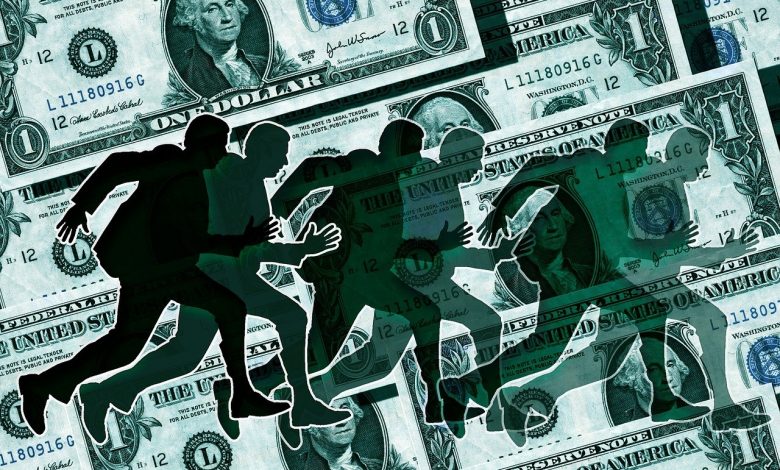Short-Term Liquidity Crisis Possible – Bullish US Dollar

The outbreak of chaos in the Afghan capital Kabul is certainly a tragic moment from the perspective of western foreign policy, but this should not distract us from developments in the financial markets.
While America is having its expected “Saigon moment” in Afghanistan and even liberal media like CNN are beginning to comment critically on the political activities of U.S. President Joe Biden’s administration, there seem to be other financial related developments on the US home front at this moment.
It is not only the deepening societal drift apart, but also a liquidity crisis that is beginning to loom on the horizon. Now, with Federal Reserve officials holding out the prospect of an end to its bond purchases starting in mid-2022, and the ECB expected to publish a roadmap for ending bond purchases in the fourth quarter, it’s really hard to avoid dealing with and addressing such a potential development as early as possible.
Citing a new report by Jim Rickards, the currency war that broke out from the fence in 2010 has taken a pause in recent years, which is not at all unusual from a historical perspective.
At the same time, those responsible for political and monetary policy in the United States are not prepared to admit the de facto instability of the American economy.
The most recently received data on (nominal) GDP growth in the U.S.A. were not only worse than previously expected, but also pointed to a significant slowdown in (nominal) economic growth in the U.S.A..
While America’s imports have been boosted over the past twelve months mainly by sending out stimulus checks (also known as helicopter money), a very different – and extremely worrying – development can be observed on the export data front.
Add to this the fact that wages and salaries in the U.S. have stagnated since October 2020, while Americans’ personal incomes have fallen by about thirty percent on an annualized basis in the face of a very significant increase in inflation. At the same time, the Payroll Protection Plan has expired and, from a current perspective, does not look likely to be renewed.
Although the U.S. dollar could continue to strengthen over the course of the next few weeks, it is conceivable that the U.S. economy will slow down even more in the third and fourth quarters, so that there could be an outbreak of panic among those in charge of the Biden administration with a view to the mid-term elections in 2022.
At that point, at the latest, it would be possible to foresee that the Fed’s electronic central bank press would be set in motion even faster than before, which could once again turn the currently envisaged plans of the Federal Open Market Committee to end the bond-buying program into their exact opposite.
Recent data show that the Fed has expanded its balance sheet book to over $8.2 trillion in the face of continued bond purchases to the tune of $120 billion per month. Compared to that period before the outbreak of the global financial crisis, this represents more than a tenfold increase (!).
However, the U.S. dollar is likely to continue its upswing against a large number of other paper currencies until the Fed’s current plans threaten to become wastepaper again. Current developments in the People’s Republic of China also contribute to this.
For example, the People’s Bank of China had recently announced that it would minimize the minimum reserve requirements that Chinese commercial banks have to meet in the lending sector. This development points not only to economic weakness in the People’s Republic of China, but also to liquidity problems among Chinese banks, from which the U.S. dollar benefits.
The U.S. dollar also appears to be benefiting at the moment from foreign governments continuing to reduce their positions in U.S. government bonds. Although on the surface it may appear to be a contradiction in terms, foreign banking systems are currently desperately trying to accumulate U.S. dollars, which is the reason for unwinding liquid positions in U.S. government bonds.
This is also indicated by a slightly inverted yield curve in the eurodollar futures markets at the moment. Based on this observation, commercial banks and institutional investors expect even lower interest rates in the future, which seems to indicate the renewed onset of a recession.
In the short term, however, major financial market players expect higher interest rates, a sign of growing liquidity stress in the financial system, which is also likely to argue in favor of a further strengthening of the U.S. dollar in the short term.
It would be difficult to forecast the extent of a liquidity crisis that would quickly emerge from the current perspective. But, as Rickards warns, this trend has been going on since March of this year, which would suggest that the outbreak of a global liquidity crisis may not be too far off. Rickards expects it could be no later than October.
DepthTrade Outlook
Not only the U.S. dollar, but also gold (not necessarily Gold/USD) should benefit from the potential onset of such a liquidity crisis. However, it is also to be expected that from that point on, the Federal Reserve’s electronic printing press is likely to rotate to an even greater extent than it has been the case so far. According to that, the U.S. dollar is likely to come under renewed pressure to continue its downward trend from this point on. It is advisable to hedge equity investments in particular in order to protect against price losses due to a possible short-term rise in the U.S. dollar. A reassessment of the situation would then be due in the third quarter. We will keep you posted on DepthTrade.com.
